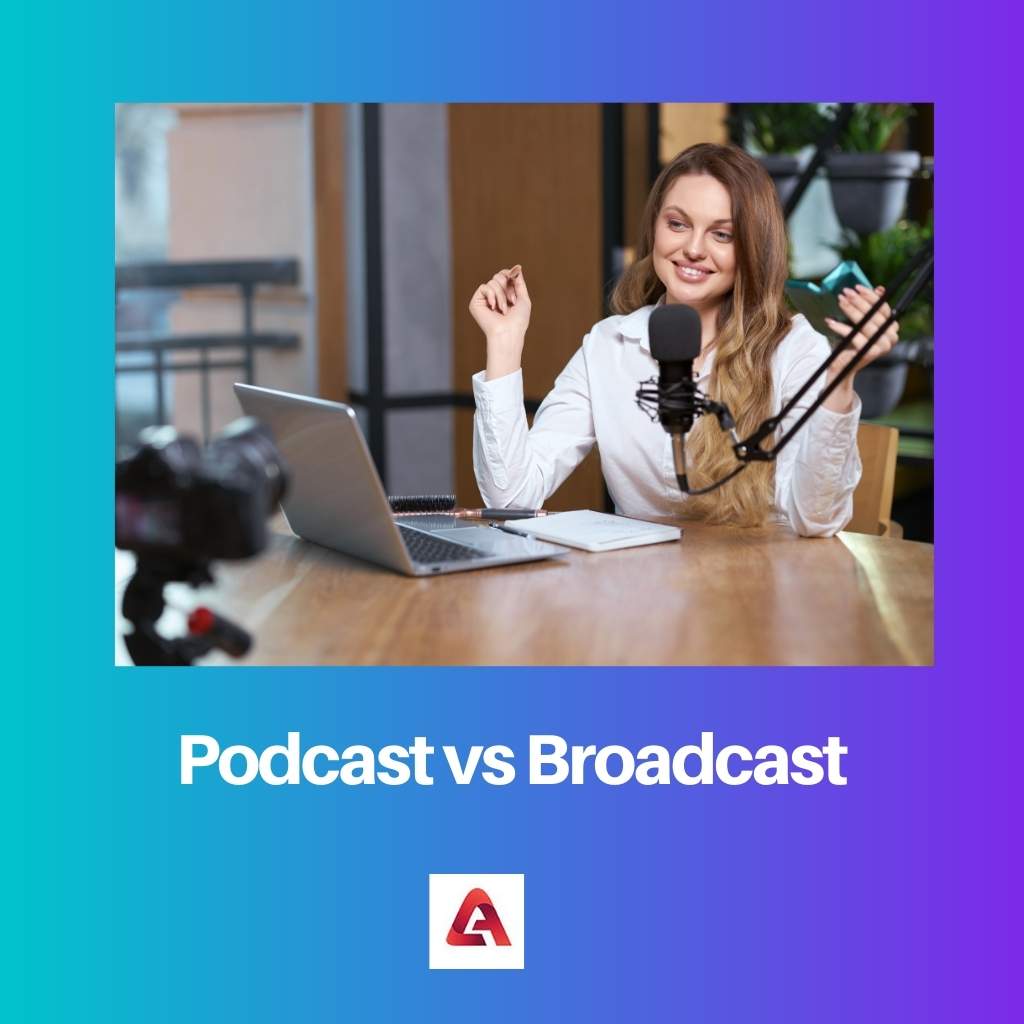The various modes of communication have been put to use for the effortless transfer of information from the sources to the target audience. With the advancement of technology, old versions keep on converting into newer, more accessible forms.
Along the same lines, podcasts and broadcasts are two different communication channels which help quickly disseminate information and provide a wide range of entertainment.
Key Takeaways
- Podcasts are digital audio files that can be downloaded and listened to on a computer or mobile device, while broadcasts are live or recorded audio or video content transmissions.
- Individuals or small groups host podcasts, while larger media organizations produce broadcasts.
- Podcasts can be listened to on-demand, while broadcasts are aired at specific times and may not be available for later listening.
Podcast vs Broadcast
A podcast is an audio program that is distributed online, through platforms such as iTunes, Spotify, or Google Podcasts. Podcasts can be downloaded and listened to on demand. A broadcast is the distribution of audio content over the airwaves, through radio or television. Broadcasts are live or pre-recorded programs that are transmitted to a wide audience through radio or television stations.

A podcast is referred to as a recorded version of information bits passed across through online modes of communication. They were popularized as voice memos and then changed into longer versions.
Once the podcast is recorded, a lot of checks and balances are applied. A series is created for each subject, and a chronological sequence is necessary.
A broadcast is the simple telecast of audio or visual or both these forms through a specific mode of transmission. Radios are considered to be the basic broadcasting devices.
An advanced version is a television. This kind of information holds a lot of significance, and the relevance is also high due to the immediate effect.
Comparison Table
| Parameters of Comparison | Podcast | Broadcast |
|---|---|---|
| Definition | It is defined as a small piece of an audio recording shared online in the form of different episodes under a particular category | It is defined as the direct transmission of information for public usage through signaled devices |
| Some Common Types | Interview, monologue, storytelling, conversation, etc | Through radio or television |
| Etymology | It has been derived from the combination of iPod and broadcast | It has been derived from “broad” meaning over a large area and “cast” meaning spread out across |
| Mode of Communication | Recorded material is uploaded and then accessed at the receiver end | In most cases, the live telecast is done through radio, while television telecasts prerecorded versions as well as live events |
| Uses | Used to propagate information through audio mode using portable devices | Used to propagate information universally through signaled devices, dependent upon a particular broadband width |
What is Podcast?
A podcast is a mode of communication that is based on the apt use of technology for sharing audio files recorded for a specific purpose. This mode helps in popularizing different fields of interest, and all the files can be clubbed together for greater relevance.
Once the podcast is uploaded, it is easy to get an idea about the audience. A webcast is a live stream of podcasts. They are not recorded and can be saved for future reference as well.
Artificial intelligence can also be applied to understand the need for podcasts and webcasts. Initially, this type of communication was only for encouraging people through various influencers and other influential people. It is essential to use a high-quality connection.
Major niches for recording podcasts include entertainment, academics, politics, and self-help. The most common type of podcast is the conversational one – a host sits in front of the guest and asks questions for the benefit of a large community of people.
All podcasts need to pass through numerous editing procedures, including noise cancellation methods.

What is Broadcast?
Broadcast is an umbrella term used to describe the real-time transmission of necessary information through various channels designated for the same purpose. Signals play an important role in the successful relay of broadcasts.
They can either be recorded or replayed if sent through television mode. Radio has no such facility as it goes live only. Only two modes of communication can be applied – audio and visual.
A particular broadcast is fixed for a fixed geographical territory. People associated with broadcasts are radio jockeys, advertisement heads, and socially influential people. The schedule of every broadcast is fixed throughout the week.
It is obsolete because there is a lot of white noise due to the disturbance in the form of sound waves and fluctuating frequencies. The instantaneous nature makes it impossible to understand the reach, and the number of attendants cannot be estimated in any form.
Interior areas and villages rely only on this model. Once the session is on air, it is not possible to undo the transmission.

Main Differences Between Podcast And Broadcast
- A podcast can be defined as a set of audio files grouped together and uploaded on electronic media routes. Broadcast is the high-level transmission of audio-visual signals for public usage across a large area.
- Some of the most common types of podcasts are conversational podcasts and monologues. Broadcasts can be subdivided into radio broadcasts and television broadcasts.
- The term podcast is made up of two derivatives – iPod and broadcast. On the other hand, a broadcast is derived from “broad”, meaning large area, and “cast”, meaning spread.
- Communication occurs through podcasts in the form of internet links and audio files. Meanwhile, broadcasts rely on satellites and radio frequencies spread across a designated area.
- The main usage of podcasts is in the field of promotions and productivity. A broadcast has wider interpretations – news, songs, speeches, etc.

- https://www.ingentaconnect.com/content/intellect/rj/2012/00000010/00000001/art00002
- https://www.sciencedirect.com/science/article/pii/S1877042814025804